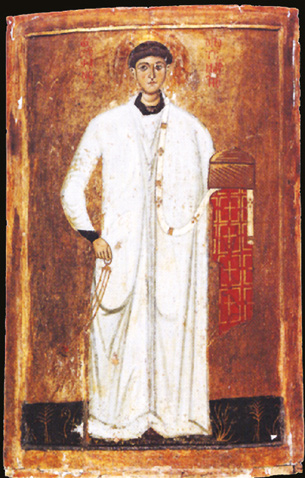The first martyr
Publish date 18-03-2023

Among the iconographic treasures preserved in the Monastery of Santa Caterina we find this ancient 13th century icon of Saint Stephen the protomartyr.
He is Stephen in the Acts of the Apostles (chapters 6 and 7), one of the seven men "of good reputation, full of Spirit and wisdom" who are entrusted with the task of service ("deacon" means precisely "minister", " servant") to tables and daily assistance to the poor and widows. We are told that he was full of grace and power, that he performed great wonders and signs among the people, and that he had great wisdom and spoke with the power of the Spirit.
A person so deeply united with Jesus that, first of all his disciples (and the apostles themselves), he faces hostility and persecution, so much so that he gives his life for him, and with words of forgiveness for his persecutors.
In fact, some Jews, coming from various cities, find themselves united in accusing him of subversion and, in order to be able to sentence him to death, they stir up the people, the elders and the scribes, capture him and bring him to the Sanhedrin to try him. After a long speech, which traces the history of salvation, full of faith and inspired, Stephen frankly affirms that Jesus is the awaited messiah, the Son of God and that those who are opposing him are opposing God's plans and the Spirit of him. This unleashes the anger of the crowd, who violently take him out of the city and kill him by stoning. Saul, who will later become Saint Paul, is present at his death and "approves of his killing".
From this moment strong persecutions against the nascent church began, by the Jews themselves, of whom Saul, in fact, was to be an energetic leader, and then by the Roman power. Yet the fact that the book of Acts specifies the presence and approval of Saul at Stephen's death tells us that it played an important part in his life and his subsequent conversion.
Saint Stephen is the first Christian martyr, i.e. the first to give his life for Jesus, but the first in a long chain that reaches up to the present day, of people so united to him as to fulfill the same parable, of a life given out of love, of so much good done to so many and of such courage as to face such a death.
In different ways, times and different places, the life of those who truly love Jesus becomes rich in goodness, in love for others, takes hidden paths that help the conversion of others, and – however – always mysteriously goes towards a certainly "martyrdom". Which is sometimes evident, striking, but many others take the form of a silent daily martyrdom, made up of misunderstandings, judgments, exclusion and mortification on the part of a part of the world that does not accept the logic of love, service, “First the others and then us”. Santo Stefano then also becomes our friend, when we find ourselves in difficulty and we remain faithful.
And we can ask him a little about his courage, his frankness, his love for Jesus.
In this icon he is depicted according to the iconographic tradition with which deacons are depicted, that is, in reference to the Eucharistic liturgy, because we remember that icons depict the saint in eternal light, in the continuous celestial liturgy, as a fragment of the immense celebration that takes place in the sky. He has a white robe, a stole that descends over his left shoulder, in his right hand the censer and in his left the casket of gifts to be offered on the altar, accompanied by a red veil as a sign of respect for the mystery in which they will participate.
Chiara Dal Corso
NP December 2022







